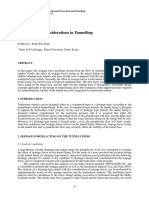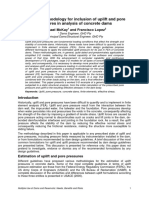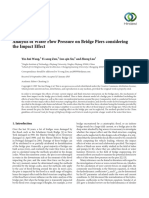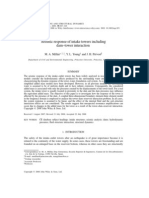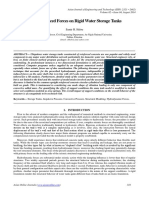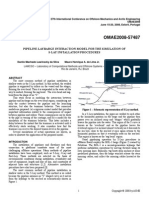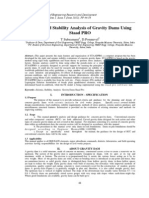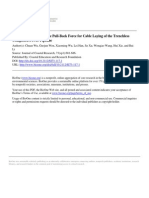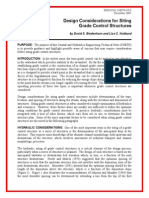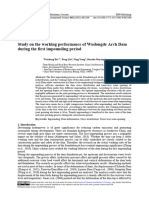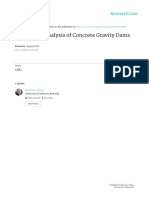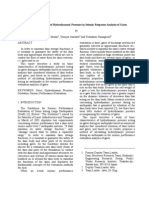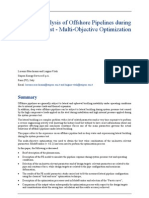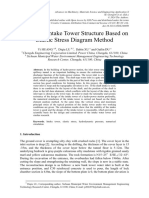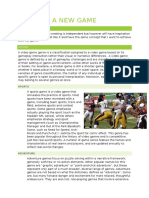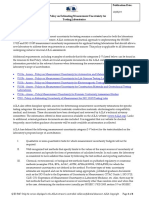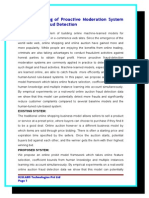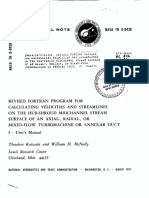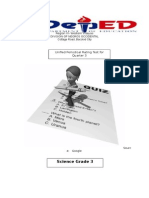Influences of Hydraulic Uplift Pressures On Stability of Gravity Dam
Influences of Hydraulic Uplift Pressures On Stability of Gravity Dam
Uploaded by
LuriezaRicablancaLuspoCopyright:
Available Formats
Influences of Hydraulic Uplift Pressures On Stability of Gravity Dam
Influences of Hydraulic Uplift Pressures On Stability of Gravity Dam
Uploaded by
LuriezaRicablancaLuspoOriginal Description:
Original Title
Copyright
Available Formats
Share this document
Did you find this document useful?
Is this content inappropriate?
Copyright:
Available Formats
Influences of Hydraulic Uplift Pressures On Stability of Gravity Dam
Influences of Hydraulic Uplift Pressures On Stability of Gravity Dam
Uploaded by
LuriezaRicablancaLuspoCopyright:
Available Formats
27
Chinese Journal of Rock Mechanics and Engineering
2008 8
Vol.27 No.8
Aug.2008
INFLUENCES OF HYDRAULIC
UPLIFT PRESSURES ON STABILITY OF
GRAVITY DAM
UTILI Stefano1 2YIN Zhenyu 2JIANG Mingjing3
(1. Department of Civil EngineeringPolitecnico di MilanoMilan 20133Italy
2. Department of Civil EngineeringUniversity of StrathclydeGlasgow G4ONGUnited Kingdom
3. Department of Geotechnical EngineeringTongji UniversityShanghai 200092China)
AbstractA study of the influences of the hydraulic uplift pressures underneath the base of a typical concrete gravity dam
on its stability is presented. The dam is located at Cumbidanovu(SardegnaItaly). The foundation of the dam is made of
heavily fractured rock. Firstlyanalytical calculations about the equilibrium of the dam as a free body have been employed
to evaluate the maximum hydraulic pressure before collapsing and to assess the impact of an effective drainage system on
the stability of the dam in a simple way. Secondlynumerical analyses by the distinct element method(DEM) using the
code UDEC have been carried out to evaluate the hydraulic flow taking place within the fractured rock foundationthe
uplift pressure distribution generated by the calculated flowand its influence on the stability of the dam. For design
purposesit emerges that availability of reliable data on the hydraulic permeability of rock foundations and a
computationally advanced distinct element modeling might lead to the acceptance of loads significantly higher than the
more conservative estimations obtained from equilibrium analyses.
Key wordshydraulic engineeringdistinct element method(DEM)hydraulic upliftdam stabilitygravity dam
CLC numberTV 642
Document codeA
Article ID10006915(2008)08155415
UTILI Stefano1 2 2 3
(1.
201332.
3.
G4ONG
200092)
Cumbidanovu
Received date20080222Revised date20080520
Foundation itemNational Science Foundation Project(50679057)Pujiang Talents ProjectShanghaiChina(06PJ14088)
Corresponding authorUTILI Stefano(1976)malePh. D.graduated from Politecnico di Milano in 2000. He is now at Strathclyde Universityand his main
research interests are mainly covered in DEMslope stabilityand limit analysis. E-mailmjjiang@excite.com
27 8
UTILI Stefano
et al. Influences of Hydraulic Uplift Pressures on Stability of Gravity Dam
1555
INTRODUCTION
stability since it may give rise to a significant vertical
force making the dam overturning about its toe and
The gravity dam investigated is located at
decreasing its frictional resistance against sliding[3 4].
The following two methods will be used to evaluate
CumbidanovuSardegnaItalyand it rests on a
the influence of the uplift thrust on dam stability
heavily fractured rock foundation. The data related to
the foundation have been taken from the results
equilibrium analysis of the dam as a rigid free
body(single wedge analysis) and the distinct element
where a detailed collection of the geological and
method(DEM). The former has been used to achieve
geotechnical
a first rough estimation of the maximum reservoir
level and some insight on the influence of the
[1]
data
for
the
site
is
available.
Concerning with the dam body instead(see Fig.1)
the geometry has been taken from the proposal A2 of
the 1999 ICOLD(International Committee of Large
Dams) held at Denver [2]USAwhich is therefore
slightly different from the real one. This assumption
however has no influence on the final results
obtained since the global size of the dam is the same
and the uplift pressure distribution underneath the
dam base is not affected by the shape of the dam
body. The objective of the ICOLD proposal was to
benchmark numerical and analytical methods for the
evaluation of the maximum sustainable reservoir
level before dam collapsing and the evaluation of the
uplift pressure distributions acting along the dam
base.
effectiveness of drainage system on stability of
the dam. The usefulness of this method for
stability calculations[4 5] for gravity dams is well
known. From a theoretical viewpointan alternative
formulation by the upper bound limit analysis
method could be adopted. According to this method
instead of the cardinal equations of statics the
balance between external work and dissipated energy
is imposed[6]but in this paperthe single wedge
mechanism formulation has been preferred for sake
of simplicity. The DEM has been used to perform a
more refined analysis calculating the uplift thrust
acting along the base of the damas a result of the
actual hydraulic flow taking place into the fractured
rock foundation for both cases of effective and
ineffective drainage system. The use of the DEM for
dam stability analyses[7] is not new but its
application to the study of seepage within the rock
foundation as a coupled hydro-mechanical problem
is quite recent in the literature since seepage in the
foundation is often calculated by finite element
analyses[8] which can not directly model the
hydraulic flows within the joints in the foundation.
For gravity damsthe most common drainage
system is made by an inspection gallery running
longitudinally above the dam base and located as
close as technologically achievable to the foundation
and several drainage holes drilled from the gallery
floor into the rock foundation(for details of the
drainage system see USACE regulations[9 10]).
Fig.1
Dam geometry
2
In the literatureit is known that hydraulic uplift
thrust due to water percolating underneath the dam
base is an important factor to be assessed for dam
EQUILIBRIUM ANALYSES OF
DAM
In this sectionSome calculations based on the
1556
2008
performed to determine the maximum sustainable
But the assessment of the effectiveness of the drains
after dam construction and reservoir impoundment is
reservoir level. According to the method adoptedthe
a difficult task. Thereforeit is common practice to
dam assumed to be rigid and static equilibrium has
make assumptions on their effectiveness taking
been imposed taking into account all the forces
values recommended by regulations issued by
acting on itthe pull of gravity upon the dam mass
designated engineering national bodies although
the lateral thrust due to the water impounded in the
rules are notin generalstrictly prescriptivein
reservoir and the pore water pressure distributed
Europe and the US at least.
equilibrium of the dam as a free rigid body will be
along all or a portion of the boundaries of the dam body.
According to the related Italian and USACE
Regulations[11
12]
The foundation has been considered impermeable
whereas the joint between dam and foundation has
the uplift pressure along the dam base may be assumed
been assumed fully permeable. To work out the
to vary linearly from the value of hydrostatic pressure
following calculationsthe upper right triangular part
generated by the reservoir underneath the dam heel
of the dam crest(see Fig.2) has been neglected since
which is w in our caseto the hydrostatic pressure
it represents only 0.52% of the total area given by
underneath the dam toe due to the water level
in case of absent drainage system
where B and H are the width of dam base and dam
downstream of the dam that is zero in our case. If a
part of the dam baseadjacent to the upstream
height respectively.
face(marked as a in Fig.2)is not compressed against
Atot = BH / 2
(1)
the foundation because of a high overturning
moment acting on the damthe uplift pressure p
under the non-compressed part must be assumed
equal to the hydrostatic pressure corresponding to
the reservoir water level(see Fig.2(a))
p = w
(2)
where and w are the reservoir water level and the
water unit weight respectively.
In case of a properly working drainage system
the distribution recommended by the regulations is
(a) Absent or ineffective drainage system
bilinearconstant under the non-compressed part of
the dam a and linearly decreasing in the
compressed part. The uplift pressure variation along
the compressed part of the dam is characterized by a
steeper gradient upstream of the drains line and a
flatter one downstream of it(see Fig.2(b)). This type
of uplift distribution is also assumed in related
results[13]. Underneath the drains linethe regulations
of many countries recommend to assume a value of
pressure ranging from 0.25 to 0.6 times the
difference between the pressure underneath the
(b) Effective drainage system
Fig.2
Uplift water pressure distribution under the dam
upstream facep = win our caseand the pressure
underneath the toep = 0 in the case. According to
the Italian Regulations[11]this value must be 0.35
Drainage is the single most effective mean of
times the aforementioned difference. Up taking this
significantly reducing the amount of uplift thrust.
recommendation in our calculations the uplift
27 8
UTILI Stefano
et al. Influences of Hydraulic Uplift Pressures on Stability of Gravity Dam
1557
pressure acting under the drains line results to be p =
0.35w. If the drains are not suitable to guarantee
such a pressure reductionstability analyses must be
performed assuming no drainage system. When the
non-compressed zone extends downstream of the
drain line(ad)thusthe recommended pressure
distribution becomes constant along the noncompressed zone and linear in the compressed one
hence falling again into the case shown in Fig.2(a).
In the following sectionthe stability of the dam
will be examined with regard to two possible
collapse mechanismsoverturning about the toe and
sliding along the dam-foundation interface joint.
Punching of the dam into the foundation or the
development of a failure surface throughout the
foundation has been disregarded since the rock
constituting the foundation is highly resistant to
crushing and shear failure. The two mechanisms
overturning and slidingtherefore will be considered
separately.
2.1 Overturning mechanism
Overturning of the dam about its toe occurs
when the overturning moment due to the lateral
thrust of the water impounded in the reservoir and to
the uplift forces acting on its base overcomes the
resistance of the stabilizing moment due to its
dead-weight. Considering first a low reservoir level
the dam rests on the foundation lying with its entire
base in contact with it. If the reservoir level is then
continuously increasedthe dam will be progressively
uplifted with an increasingly smaller part of its base
in contact with the foundation until the contact reduces
to one pointits toeand overturning effectively occurs.
In this casethe vertical net reaction force exchanged
between dam and foundation N passes through
the only point of contact O(see Fig.3). In this case
the uplift pressure along the dam base isaccording
to the regulationsuniform and equal to w since a =
B and therefore ad. In order to determine the
reservoir level responsible of overturningoverturning
it is enough to impose the equilibrium of moments
around the point O
H
H
B 2
+ S2
+ U WB = 0
(3)
3
2
2 3
where S1 and S 2 are the triangular and rectangular
S1
Fig.3
Forces acting on the dam at incipient overturning
(sliding is not considered)
components of the lateral thrust respectivelyU is the
uplift thrustand W is the dam dead-weight.
After calculation of the forces and some passages
(see Appendix)the reservoir level at incipient overturning is achieved
overturning
c B 2
2 H + 1
w H
=
= 80.21 m
2
B
3 + 1
H
(4)
where c is concrete unit weight c = 24 kN/m3.
Considering now a reservoir level overturning
but high enough to uplift a part of the dam base from
the foundation(a0)the position of N is unknown
and therefore the problem becomes statically
indeterminate. To solve the problemit is necessary
to introduce a hypothesis on the distribution of the
effective normal stresses along the compressed part
of the dam against the foundation. Firstif the dam is
considered as a rigid bodyand the reaction offered
by the foundation by means of Winklers elastic
springs with constant stiffnessthe distribution of the
normal stresses is triangular(see Fig.4(a)). But in
realitythe more the dam is subjected to a higher
overturning moment under an increasing reservoir
levelthe more its toe will be compressed against the
foundationand therefore the zone of the dam near
the toe will be subjected to high compressive stresses
1558
(a) Triangular
Fig.4
2008
(b) Real
(c) Uniform
Stress distributions along the compressed zone of the
dam base with x/3cx/2
leading to plastic stress redistribution. In factit is
(a) Absent drainage system
well known that concrete undergoing high compressive
stresses exhibits a stress-strain relationship progressively
drifting away from linearity until crushing occurs.
This implies that along the dam zone in compression
x = B a the normal stresses will vary nonlinearly
as shown in the distribution in Fig.4(b). To find out
Triangular stress distribution with
effective drainage
Uniform stress distribution with
effective drainage
the real stress distribution is a complex problem that
would require nonlinear 3D finite element analyses.
To bracket the real stress distributiontwo distributions
(b) Effective drainage system
were assumeda triangular and a uniform one. In the
former case N is applied at x/3 from the dam toe
Fig.5 Reservoir level vs. non-compressed zone length
whereas in the latter one at x/2 with the true line of
action of N lying somewhere in between x/3 and
obtained in case of triangular stress distribution are
x/2.
distributionsince the destabilizing moment due to
N is smaller because of a shorter lever arm(x/3
To determine the extension of the uplifted part
of the dam baseagiven a known reservoir level
it is necessary to impose the equilibrium of moments
for the forces acting on the dam assuming point O
as the pole
overturning
= M stabilising
(5)
In Appendixthe analytical calculations are
higher than those obtained in case of uniform
instead of x/2).
Looking now at Fig.5(a)the gap between the
two curves reduces with increasing auntil it becomes
nil at a = B = 60 mwhen overturning occurs. Since
the dam is in contact with the foundation only in one
pointits toeand the location of N becomes
shown. Depending on the two distributions adopted
independent of the assumed stress distribution.
two different polynomial expressions were found
In case of effective drainage systemthe analytical
expressions = (a) obtained for ad give rise to
triang = ( a)
(6)
higher values than the case of absent drainssince
Since the real normal stress distribution has
effective drainage allows a significant reduction of
uplift pressures making the dam much more stable
uniform = 1 ( a)
been bracketed by the two distributions assumed
also the real relationship real = (a) will be bracketed
by the two functions in Eq.(6). In Fig.5the real
function will lie in the region of space enclosed by
the two linesthe gray onecorresponding to triang
and the black one corresponding to uniform. In Fig.5(a) it
is shown the case of ineffective or absent drainage
system whereas in Fig.5(b) the case of effective
drainage. In the graphsthe reservoir levels triang
(compare Fig.5(a) with Fig.5(b) for a d ) . But
when the non-compressed zone goes beyond the
drains linethe drains must be considered ineffective
according to the regulations[11
12]
and therefore uplift
water pressures suddenly increase to the value they
assume in case of absent drains(see Fig.6). This is
due to the fact that when the dam is uplifted beyond
the drains line an effective water interception by the
drainage system is no longer possible. In Fig.5(b)
27 8
Region 1
UTILI Stefano
et al. Influences of Hydraulic Uplift Pressures on Stability of Gravity Dam
1559
Region 2
Fig.6 Uplift pore pressure distributions in case of a1d
(region 1) and a2d(regions 1 + 2)
the dashed curves for ad are the same curves as
the solid ones plotted in Fig.5(a) for the case of absent
drainage system. They are dashed to point out that
they are only theoretical ones. In factconsidering
the dam subjected to an increasing reservoir levelas
soon as the uplifted zone goes beyond the drains
line a sudden increase of a occurs at constant
reservoir level. In case of uniform distributionthe
reservoir level may continue to be increased even
after the uplifted zone has gone beyond the drains
line until the dam overturns around its toe(a = B)
whereas in case of triangular distribution the
reservoir level cannot be further increased since the
reservoir level reached at a = d = 10 m is larger than
overturning. Hencein case of uniform distributionthe
presence of drains increases the load bearing capacity
of the dam only for values of a17 mwhereas in
case of triangular distributionfor any value of a.
2.2 Sliding mechanism
Resistance against horizontal sliding is given by
a frictional component proportional to the net vertical
force exchanged between dam and foundation N
and a cohesive one. This force opposes the lateral
thrust due to the water impounded in the
reservoir(see Fig.7). If Tres is the resisting forceit is
given by
Tres = N tan + cx
calculation for the sliding mechanism
From Eq.(8)two polynomial functions = (a)
are obtained one in case of absent drainage
system(see Fig.8(a)) and the other in case of
effective drains(see Fig.8(b)). In both cases the
reservoir level decreases with increasing a. This is
because the higher the value of a the less the
cohesive part of the resisting forceand therefore the
lower the value of .
(a) Ineffective drains
(7)
where and c are the friction angle and the
cohesion along the dam base with N calculated by
imposing the vertical equilibrium of forces.
The relationship between the reservoir level
and the extension of the non-compressed zone ais
found imposing the horizontal equilibrium(details of
the calculations are given in Appendix)
Tres = Tact
Fig.7 Forces acting on the dam taken into account in the
(8)
(b) Effective drainage system
Fig.8 Reservoir level vs. uplifted zone in case of ineffective
drains and effective drainage system
1560
2008
2.3 Determination of the dam bearing capacity
this condition does not lead to collapse since the
To determine the bearing capacity of the dam
reservoir level can still be increased prior to the onset
the two investigated mechanisms must be analyzed
of sliding. In realitythe normal stress distribution
together. In Fig.8a graph is shown in terms of
reservoir level versus length of the uplifted zone
will be neither linear nor uniform but something in
along the dam basea. The curves related to the
analyses performed if the attainment of the condition
overturning mechanism are given by solid lines
whereas the curves related to sliding are given by
a = d leads to the collapse of the dam or there is still
cross lines. The real collapse load is given by the
system is presentedhigher reservoir loads can be
between so it is not clear from the equilibrium
a margin of safety. Howeverif an effective drainage
minimum collapsing load determined for each
mechanism taken separately. Thereforeconsidering
sustained by the dam in so far as the drainage system
remains efficient i.e. the uplifted zone remains
the dam under an initially low and then increasing
upstream of the drains linead.
reservoir levelthe more critical failure mechanism
is overturning since it is associated with the lower
curve. This means that the dam will be gradually
uplifted because of increasingly higher overturning
moments(see curves with pointed arrows in the
DISTINCT ELEMENT ANALYSES
The specifications of the A2 proposal of the
ICOLD Benchmark 99 do not provide data related to
graphs). The dam upliftin turnwill progressively
the dam foundation. These have been taken from the
decrease the resistance against sliding along the dam
foundation interface(see the descending curves in
foundation of Cumbidanovus dam[1]. Insteadthe
geometry of the dam and its mechanical properties
Fig.8 related to the sliding mechanism). When the
have been assumed according to the Benchmark
curve related to the overturning mechanism and the
curve related to sliding meet in point A for the case
specifications that are consistent with the equilibrium
analyses. These are given in Table 1.
of triangular distribution and point B for the case of
Concerning the jointsa Mohr-Coulomb shear-
uniform distributionthe collapse of the dam occurs.
In correspondence of those pointsit happens that
strength relation has been adopted. The dam-foundation
Tres becomes smaller than Tact and the dam starts
joint is characterized by a softening behavior as
sliding downstream.
The collapse load calculated by the performed
prescribed by the ICOLD specifications(see Fig.9). The
equilibrium varies within a precise rangefrom 76.5
mechanical parametersalso reported in Table 1are
given byc = 0.7 MPa = 30 = 10(dilation
to 78 m in case of absent/ineffective drainage system
(line AB in Fig.8(a))from 76.5 to 81.8 m in case of
angle) f t = 0(tensile resistance) cres = 0(residual
= 30(residual friction angle). The joints
cohesion) res
effective drainage system(line AB in Fig.8(b)).
In case of linear stress distributionas soon as
in the foundations are characterized by the following
parameters[1]c = 0 MPa = 30 = 0 f t = 0
the uplifted zone goes beyond the drains linesliding
MPa. Water viscosity K j has been assumed equal to
occurs whereas in case of uniform stress distribution
K j = 300 Pas 1.
Table 1
Methods
Summary of the physico-mechanical parameters used in calculation
Dam
Foundation
Dam-foundation joint
c/(kNm 3)
Ec/GPa
rock/(kNm 3)
Erock/GPa
rock
/(
)
c/MPa
/(
)
ft
res/(
)
cres
Equilibrium analysis
24
24.5
0.17
30
0.7
DEM
24
24.5
0.17
26
20
0.3
30
0.7
10
30
Methods
Joints in foundation
Kj/(Pas 1)
ha0 /mm
300
0.5
5104
5102
/(
)
c/MPa
/(
)
ft/MPa
Equilibrium analysis
DEM
30
hares /mm
KN/(kNm 1)
KS/(kNm 1)
27 8
UTILI Stefano
et al. Influences of Hydraulic Uplift Pressures on Stability of Gravity Dam
1561
In order to perform a meaningful analysis the
choice of the hydraulic conductivities along the
joints is critical. To verify that the chosen values
ha0 = 1 mm and hares = ha0 / 2 are adequate for the
problemthe simpler case of non-fractured foundation
has been analyzed in order to check the agreement
Tension t
Fig.9
with the equilibrium analyses performed in Section 2.
Shear strength of the dam-foundation joint according
[2]
to the Mohr-Coulomb criterion
In Fig.11it is shown the pressure distribution at
incipient collapse with athe length of the uplifted
part of the dam base beyond the drains line. This
tangential mechanical joint stiffnessesK N and K S
distribution is well in agreement with that taken from
the referenced regulations and assumed in the
respectivelyand the joint hydraulic apertures ha0
equilibrium analyses(see Fig.2(a)for the case a
Other parameters such as the normal and
and hares have been selected by the authors.
The regulations taken as a reference for the
d ). This match corroborates the goodness of the
hydraulic apertures adopted in the UDEC analyses.
equilibrium analyses only specify the reduction of
uplift pressure operated by the drains without any
indication in regard to the hydraulic flow along the
drains. Therefore the same hydraulic condition
assumed in Section 2 has been implemented into the
distinct element analyses by assigning a fixed pore
pressure value p = 0.35w at the point of
intersection between the drains line and the
dam-foundation joint.
Fig.11 Pore pressure distribution underneath the dam
In Fig.10it is shown the relationship between
hydraulic aperture and normal stress adopted in the
code UDEC[14
assuming intact foundation(reservoir level
= 80 m)
15]
the maximum hydraulic aperture
along a joint is reached when the compressive stress
goes to zero ha0 in the figurethen the hydraulic
aperture varies linearly to a residual valuehares with
m given by
K N and K S the mechanical stiffnesses of the
jointsrule the amount of mechanical overlapping
allowed between two adjacent blocks but they also
greatly influence the time needed to run a simulation
since the stability of the integration scheme used to
m = 1 / K N
(9)
solve the equations of motion is explicit and the time
step adopted by the code is inversely proportional
to the square root of K. Here there are two
conflicting objectives which can be labeled asfast
computations andrealistically deformable joints.
Tension t
After some preliminary analysesK N = 5104 kN/m
1
and K S =
K N have been proven suitable for the
100
problem.
3.1 Analyses
Fig.10 Hydraulic aperture of jointhavs. stress normal to
jointnwithin the rock foundation
[14]
The effect of the inclination and spacing of the
joints has been studied assuming four different
1562
geometries. The total of the presented models is
eight for each set of joints both cases of absent and
effective drainage system have been considered(see
Table 2). In the first configurationthe joints form a
+45 angle with the horizonthe spacing between
joints beingin model a6 m for the first set and 12 m
for the second setin model b12 m for the first set
and 6 m for the second set. In model cthe first set of
joint is +15 inclined over the horizon with 6 m
spacing and the second set 69with 12 m spacing
whereas in model dthe first set is +15inclined over
the horizon with 12 m spacing and the second is
69
with 6 m spacing.
Table 2
Summary of the models analyzed
Joint
inclination
Model
Drains
to the
)
horizon/(
a
b
c
d
UDEC
LE analysis
Block
analysis bearing
bearing
size
/(mm) capacity /m capacity /m
a1
+45
No
126
87
76.578.5
a2
45
Yes
126
91
76.581.8
b1
+45
No
612
85
76.578.5
b2
45
Yes
612
87
76.581.8
c1
+15
No
126
77
76.578.5
c2
69
Yes
126
80
76.581.8
d1
+15
No
612
75
76.578.5
d2
69
Yes
612
80
76.581.8
2008
The loads(dam weight and reservoir level) were
applied progressively in successive steps in order to
achieve equilibrium conditions in a quasi-static way
avoiding to introduce any inertial effects. Firstthe
load of the dam was applied to the foundation
increasing the dam dead-weight by stepsand then
the reservoir load was assigned by steps until the
dam collapsed. After each stepa number of cycles
large enough for the system to reach static
equilibrium was run. Some preliminary analyses
were performed to determine the minimum number
of steps for which the influence of the loading
procedure on the final results is negligible.
The reservoir level was increased by 5 m steps
up to the collapse of the dam. Thenthe analysis was
resumed from the last step of loading before collapse
and smaller increments of reservoir level were assigned
to identify with better accuracy the reservoir level
causing collapse. Collapse was detected looking at
the displacement undergone by the dam. After the
total displacement of the crest exceeded 0.5 mthe
analysis was stopped.
In all the simulations runa small numerical
damping was used. This damping is given by decreasing
block accelerations and increasing block decelerations
Each block of rock and the dam have been
assumed linearly elastically deformable. To impose
the elastic laweach rock block in the foundation has
been subdivided into four regular triangles whereas
the dam has been subdivided into non-regular triangular
elements(see gray lines in Fig.12). Thenstresses and
strains were calculated by UDEC in the nodes of
each mesh every time-step.
by a factor proportional to the unbalanced forces
acting on each block. It was used only to shorten the
computational time needed to run a simulation and
therefore it has no particular meaning but its use is
justified as long as it does not affect the global
response of the assembly of blocks to the mechanical
and hydraulic actions imposed. Some preliminary
tests with zero damping were run to verify that the
introduced damping had a negligible effect in terms
of the analyzed global variables.
3.2 Results
For all the joint configurations analyzedthe
maximum hydraulic flow takes place along the
dam-foundation joint and it has been noted that the
greater the distance of a joint from the dam base is
the smaller the flow is. This is due to the fact that
the hydraulic conductivity of the joints depends on
the compressive stresses. For increasing depths
Fig.12
Domain of analysis(model c)black lines indicate
compressive stresses increase and the hydraulic
edges of blocksgray lines indicate the mesh contour
conductivity decreases as a result.
27 8
UTILI Stefano
et al. Influences of Hydraulic Uplift Pressures on Stability of Gravity Dam
1563
In Fig.13 it is shown the hydraulic flow
monitored along the dam-foundation joint with the
the damwhen a = 0 the distribution is quite in
dam at incipient failureeach point in the graph
In case of absent/ineffective drainagesit is linear
indicates the flow along one hydraulic domain
extending between two consecutive rock joints
(see Fig.15(a))whereas in case of effective drains in
operationthe distribution changesit is still linear
intersecting the dam-foundation joint. It can be noted
upstream of the drains but becomes parabolic-like
that in case of absent drainage systemthe flow is
almost constant. In case of effective drainage system
insteadthe flow along the upstream part of the joint
is more than twice as high as the flow in the previous
casewhereas the flow along the downstream part
of the jointfrom the drains line to the dam toe
remains lower than the previous case with a jump in
correspondence of the drainage point. Moreoverthe
agreement with what prescribed by the regulations.
downstream of them(see Fig.15(b)) slightly different
from what prescribed by the regulations. After the
dam starts upliftinga0the obtained pressure
distributions strongly depend on the geometry of the
rock jointsdrifting substantially from the prescriptions
of the regulations.
Dam base/m
the hydraulic flow in a large area of the foundation.
Depending on the inclination of the rock jointsit
may also happen that the flow along the damfoundation interface goes upstream for a short
length(see Fig.14just before the drains line).
Pore pressure/kPa
presence of the drainage system greatly influences
0
100
200
300
400
500
600
700
800
10
20
30
40
50
60
Model b
Model d
Regulations
h = 85 mm(no drainage system)
h = 87 mm(drainage system)
20
Dam base/m
15
10
5
0
10
20
30
40
50
60
Dam-foundation joint/m
Fig.13
Hydraulic flow along the dam-foundation interface
at incipient collapseblack line in case of effective
drainage system and gray one in case of absent
drainage system
Pore pressure/kPa
Hydraulic flow /(Ls 1)
(a) No drainage
25
0
100
200
300
400
500
600
700
800
10
20
30
40
50
60
Model b
Model d
Regulations
(b) Active drainage
Fig.15 Uplift pressures with the dam base all in contact
against the foundationa = 0in case of models
b and d with reservoir level = 70 m
The load bearing capacity of the dam varies a
lotdepending on the geometry of the joints in the
foundation(see Table 2). Making a comparison with
the equilibrium analyses of Section 2it is possible
to say that in case of joints inclined 45on the
horizontal linethe resulting bearing capacity ison
average7 m higher than the equilibrium analysis
Fig.14
Hydraulic flow directions underneath the dam
with drainage system in operation
With regard to the uplift pressure underneath
predictionswhereasin case of joints inclined +15/
69 on the horizontal line(cases c and d) the
bearing capacity is within the range predicted by
equilibrium analyses. The physical explanation is as
1564
2008
followsin models a and bgiven a known reservoir
level a smaller length a and lower water pressures
Fig.17 provides the horizontal displacements of
the left edge of the dam crest during the reservoir
underneath the dam were generated leading to a
filling until the last step of loading before failure.
larger resistance against sliding. On the contraryin
models c and dgiven the same reservoir level a
The trend shown in Fig.17 is reasonable at the
beginning the crest moves upstreambeing the dam
larger length a and higher uplift pressures were
rotating counterclockwiseand then moves downstream
generated leading to a smaller resistance against
sliding. In factresistance against sliding depends
with the dam rotating clockwise. The horizontal
asymptote in the figure indicates the onset of the
for its cohesive termon the extension of the zone in
sliding of the dam along the foundation.
contact with the foundation B-a and for its
frictional termon the amount of N (see Eq.(7))
that in turn depends on the uplift pressures.
Using UDECit is also possible to investigate
the displacements undergone by the damotherwise
not achievable by the equilibrium analyses performed
in Section 2. During its process of construction and
until the reservoir level becomes half full(about 35 m)
the dam tends to tilt towards the reservoir. Then
further increases of the reservoir level lead to a
Fig.17
Horizontal displacements recorded at the dam crest
vs. reservoir level
change of direction the dam tilting towards the
opposite side(see Fig.16).
CONCLUSIONS
By means of static equilibrium analysesit has
been possible to achieve analytical expressions for
the bearing capacity of a typical Italian gravity dam
resting on a rock foundation. To this endthe uplift
thrust due to the hydraulic pressures underneath the
dam and the beneficial effect of an effective drainage
system were taken into account by assuming uplift
(a) = 35 m
pressure distributions recommended by the Italian
and USACE regulations.
Secondlya more refined analysis was carried
out by the DEM. The hydraulic flow taking place
within the fractured foundation and the influence of
different geometries of rock joints on the uplift thrust
andas a resulton the dam bearing capacity was
investigated. With this numerical methodit was also
possible to monitor the displacements undergone by
the dam.
Both methods are shown to be viable ways of
(b) = 85 m
Fig.16
investigating the influence of the hydraulic uplift
Dam and rock foundation for model b with reservoir
pressures on the stability of dams. Comparing the
level(deformations magnified by 100 times)
obtained resultsequilibrium analyses give rise to
27 8
UTILI Stefano
et al. Influences of Hydraulic Uplift Pressures on Stability of Gravity Dam
more conservative predictions in terms of dam
[6]
1565
bearing capacity whereas the DEM is a more
[J]. 2006 25(3)533 538.(XU
powerful numerical tool which can be relied on to
Qianjun LI Xu CHEN Zuyu. Three-dimensional stability
accept less conservative predictionssince it can also
analysis of dam foundation of Baise hydro-junction[J]. Chinese
model the hydraulic flow within fractured rock
Journal of Rock Mechanics and Engineering200625(3)533
foundations.
538.(in Chinese))
For design of new dams or evaluation of existing
[7]
onesin light of the analyses performedit emerges
[J]. 200625(6)1 226
the importance of having both reliable data about the
1 232.(ZHANG ChongHOU YanliJIN Fenget al. Analysis of
hydraulic permeability of rock foundations and a
arch dam-abutment stability by 3D deformable distinct elements[J].
computationally advanced modelinge.g. DEMso
Chinese Journal of Rock Mechanics and Engineering200625(6)
that loads significantly higher than the estimations
1 2261 232.(in Chinese))
obtained from equilibrium analyses might be accepted.
[8]
200726( 1)3 0173 024.(XIANG
ACKNOWLEDGEMENTS The authors would like
Yan WU Zhongru. Analysis theory and method of crossfeed
to thank the staff at Politecnico di Milano(Milan
between concrete dam body and foundation[J]. Chinese Journal of
Italy)in particular Professor R. Nova and Professor F.
Rock Mechanics and Engineering200726(Supp.1)3 017
Calvetti for their support. The support of Itasca C.G.
is also gratefully acknowledged.
3 024.(in Chinese))
[9]
1995.
[10]
BONINI M. Studio delle condizioni di flusso idraulico nellammasso
Department of the Army1986.
[11]
1999.
[2]
n.]1982.
[12]
LIU J FENG X T DING X L. Stability assessment of the Three
modelingpart IInumerical modeling[J]. International Journal of
[5]
U.S. Army Corps of Engineers. Gravity dam design engineer
manual 111022200[S]. WashingtonD. C.Department of the
Gorges dam foundation China using physical and numerical
[4]
MINISTERO L P. Norme tecniche per la progettazione e la
costruzione delle dighe di sbarramento(DM No.44)[S]. Roma[s.
ICOLD. A2 benchmark proposal for numerical and analytical
methods for gravity dams[R]. DenverUSA[s. n.]1999.
[3]
U.S. Army Corps of Engineers. Seepage analysis and control for
damsengineer manual 111021901[S]. Washington D. C.
roccioso di fondazione di una diga a gravita mediante il metodo
degli elementi distinti[Ph. D. Thesis][D]. Politecnico Torino[s. n.]
U. S. Army Corps of Engineers. Grouting technologyengineer
manual 111023506[S]. WashingtonDepartment of the Army
References()
[1]
. [J].
Army1995.
[13]
Rock Mechanics and Mining Sciences200340(5)633652.
[J]. 2007 26(8)
YU XZHOU Y FPENG S Z. Stability analyses of dam abutments
1 594 1 602.(CHANG Xiaolin JIANG Chunyan ZHOU Wei
by 3D elastoplastic finite-element methoda case study of Houhe
et al. Equal safety factor method and its reliability analysis for rock
gravity-arch dam in China[J]. International Journal of Rock
foundation of dam[J]. Chinese Journal of Rock Mechanics and
Mechanics and Mining Sciences200542(3)415430.
Engineering200726(8)1 5941 602.(in Chinese))
[14]
Itasca Consulting Group Inc.. Universal distinct element codeuser
[J]. 200527(6)657661.(HOU
manual(Version 3.0)[R]. Denver Itasca Consulting Group Inc.
YanliZHANG ChongZHANG Chuhanet al. Simulation of
1999.
upward-sliding failure of interface in arch dams by deformable
[15]
CUNDALL P A. UDECa generalized distinct element program
distinct elements[J]. Chinese Journal of Geotechnical Engineering
of modeling jointed rock[R]. [S. l.]European Research Office
200527(6)657661.(in Chinese))
US Army1980.
1566
2008
APPENDIX
A.1 Overturning mechanism
In the followingit is shown the detail of the
derivation of Eq.(4) from Eq.(3). The forces in Eq.(3)
are given by
H2
S1 = w
S 2 = w ( H ) H
(A1)
U = w B
BH
W =c
2
Thereforesubstituting them in Eq.(3)it can be
obtained
H3
H2
B2
H
w
+ w ( H )
+ w
= c B2
(A2)
6
2
2
3
Thenit can be written
B2 H 2
H wH3
= c B 2
+
+
w
2
3
3 (A3)
2
3 w ( B 2 + H 2 ) = 2 c B 2 H + 2 w H 3
(a) ad
And finally
B 2
2 H c + 1
w H
=
2
B
3 + 1
H
(A4)
Hereafterit is shown the derivation of the analytical
functions i = i (a) giving rise to the graphs plotted
in Fig.5. Lets start with the case of effective drainage
system and ad as shown in Fig.A1(a). In this case
Hthe forces acting on the dam are
Imposing the equilibrium of moments about point
O(see Fig.A1(a))leads to
f = 0.35
U 1 = w a
1
U 2 = w (1 f ) ( d a )
2
U 3 = w f ( d a )
1
U 4 = w f ( B d )
BH
W =c
2
S1 = w
(b) ad
Fig.A1 Forces acting on the dam overturning mechanism
S1
(A5)
a
2
+ U 1 B + U 2 (d a ) + B d +
3
2
3
2
1
U 3 (d a ) + B d + U 4 ( B d ) +
3
2
2
(A6)
N' x W B = 0
3
Imposing the vertical equilibrium N can be
expressed by
N = W U1 U 2 U 3 U 4
(A7)
Let us consider first the case of uniform stress
27 8
distribution x =
UTILI Stefano
et al. Influences of Hydraulic Uplift Pressures on Stability of Gravity Dam
Ba
. Substituting N and x into
2
Eq.(A6)
S1
a
d
+ U1 B + U 2 a + B +
2
3
3
1567
The function f (a) = 0 may be rewritten as a
third degree polynomial function
A0 3 + A1 2 + A2 + A3 = 0
(A12)
with the coefficients Ai depending on the parameter a
A0 = 1.67
A1 = 0
A2 = 0.541 7a 2 + 164.2a + 2 033
A3 = 28 800a 576 000
2
B a
2
a d
U 3 + B + U 4 B d +W
3
2 2
3
2 2
B a
B a
B a
U1 U 2 U 3
2 2
2 2
2 2
2
B a
U4 W B = 0
3
2 2
(A8)
Then
(A13)
A third degree function always presents three
solutionsbut in this case only one is real. Sousing
the available well known algebraic formulaeafter
a B a
B a
2 d
S1 +U1 B + +U 2 a + B + +
3
2 2 2
2 2
3 3
some more calculations the sought expression
= (a) with B = 2 168.6 10 3 a 43 373 10 3 and
B a
B a
2
2
a d
U3 + B + + U4 B d + +
2 2
3
2 2
3
2 2
C = 2.713 9a 2 + 822.44a + 10 186 can be obtained
B a 2
W B = 0
2 2 3
(A9)
+U1
B
a d B
+U 2 + +
2
6 3 2
case of ad the pore pressure distribution changes
radically(see Fig.A1(b)). The forces involved in the
equilibrium of moments are the same as before except
(A10)
for the pore water pressure. The forces due to the
water pressure are(see Fig.5(b))
Now all the forces can be replaced by their
analytical expressions obtaining
U 1 = w a
1
U 2 = w (B a )
2
B
1
+ w a + w (1 f ) (d a )
6
2
2
cB
as illustrated aboveanother third degree polynomial
function is achieved which again has only one real root
1
a B 2
( B d ) + d +
2
2 6 3
H a B
= 0
2 2 2
(A15)
Thenfollowing the same calculation procedure
d B
a d B
+ + w f ( d a) + +
2 2
6 3 3
w f
B + B 2 + 4C 3
2
black solid curve in the right side(ad) of Fig.5(b). In
a B 2
d B
U3 + + U4 + d +
2 6 3
2 2
a B
W = 0
2 6
(A14)
The function achieved in Eq.(A14) is plotted as a
And then
S1
1 B + B 2 + 4C 3
C
5
2
then applying again the algebraic formulae with B =
2 168.6 10 3 a 43 373 10 3 and C = 2.713 9a 2 +
(A11)
Substituting the known parameters with their
numerical valuesan expression of the type f(a)=0
can be obtained.
This expression Eq.(A11) can be solved either in
822.44a + 10 186
12
6
B + B 2 + 4C 3
C
2
2
3
B + B + 4C
2
(A16)
The function = (a) achieved in Eq.(A16) is
a or . In the following calculations has been
considered as a variable and a as a parameter so that a
plotted as a black partly solid and partly dashed curve
function of the type = (a) is obtained consistently
drainage systemthe forces acting on the dam are
with Fig.5where is plotted against a.
in the left side(ad) of Fig.5(b). In case of absent
those shown in Fig.A1(b). Imposing the equilibrium of
1568
2008
moments leads to Eq.(A16) whichin this caseis valid
w a and U 2 = w ( B a) / 2 . Therefore
for any value of a. The graphs obtained are visible in
N = W U 1 U 2 = c BH / 2
Fig.5(a).
In case of triangular stress distributionthe same
calculations are performed. The only difference is the
Ba
value of x which becomes x =
. In case of da
3
it happens that H and therefore the lateral thrust
w a w ( B a) / 2
It is now possible to get the two forces Tact and
Tres
Tres
w H / 2 and S2 = ( H ) w H . The obtained functions
2
have been plotted as gray curves in Fig.5(a) and
Fig.5(b).
Let start with the case of effective drains. Two
different expressions hold true depending on the
extension of awhich can be larger or smaller than d.
For the sake of spacehere only one case will be
shownadbeing this the case for which sliding
effectively takes place(see Fig.8). The derivation
shown hereafter is also valid for the case of absent/
ineffective drainages since the uplift forces acting on
the dam are the same(see Fig.2(a)).
Considering the case of H the horizontal
forces due to the lateral thrust caused by the reservoir
are S1 = w H 2 / 2 and S 2 = ( H ) w H . Defining
the horizontal force causing sliding Tact and the one
opposing sliding Tres it can be written
Tact = S1 + S 2
Tres
= N tan + c ( B a)
(A17)
N is achieved by the vertical equilibrium as
shown for the overturning mechanism. The forces due
to the water pressureas shown in Fig.7are U 1 =
BH
= tan c
tan w a
2
( B a)
tan w
+ c ( B a )
Tact = w H w
is no longer expressed by one force but two S 1 =
A.2 Sliding mechanism
(A18)
H2
2
(A19)
Imposing the horizontal equilibrium Tact = Tres
leads to
w H w
tan w
H2
B
= tan w a tan w +
2
2
a
BH
+ c ( B a)
+ tan c
2
2
(A20)
Rearranging with the objective of getting a
function of the type = (a)
w H + tan w a + tan w
B
a
tan w =
2
2
H2
BH
+ tan
+ cB ca
2
2
and then
(A21)
2ca + 2cB + w H 2 + tan c BH
=
tan w a + 2 w H + tan w B
1 400 a + 214 470
5.77a + 1 946
(A22)
In case of Hthe same calculations hold true
with the only difference due to Tact that becomesTact =
2
w
.
2
You might also like
- Research PaperDocument28 pagesResearch PaperLuriezaRicablancaLuspo56% (18)
- Subsea Pipeline StabilityDocument9 pagesSubsea Pipeline StabilityJhy MhaNo ratings yet
- Analysis of External Water Pressure For A Tunnel in Fractured RocksDocument12 pagesAnalysis of External Water Pressure For A Tunnel in Fractured Rocksdafo407No ratings yet
- Dam AnalysisssDocument12 pagesDam AnalysisssCHOEYING DEMANo ratings yet
- Water Force 1Document14 pagesWater Force 1gerea994047No ratings yet
- 6 Seepage Force Considerations in Tunnelling PDFDocument7 pages6 Seepage Force Considerations in Tunnelling PDFbiles1234No ratings yet
- Numerical Analysis For Pipeline Installation by S-Lay MethodDocument9 pagesNumerical Analysis For Pipeline Installation by S-Lay MethodGiuseppe PasqualeNo ratings yet
- Uplift PressureDocument10 pagesUplift PressureBurhan Ahmad100% (1)
- Research Article: Analysis of Water Flow Pressure On Bridge Piers Considering The Impact EffectDocument9 pagesResearch Article: Analysis of Water Flow Pressure On Bridge Piers Considering The Impact EffectmsheshappaNo ratings yet
- Seismic ResponseDocument23 pagesSeismic Responsemnazzal17No ratings yet
- A PalmerDocument10 pagesA Palmerabhi1648665No ratings yet
- Bernitsas M M.Problems in Marine R.Jan.1982.MT PDFDocument10 pagesBernitsas M M.Problems in Marine R.Jan.1982.MT PDFdanilo laraNo ratings yet
- Seminar Paper Manish SharmaDocument8 pagesSeminar Paper Manish SharmaManish SharmaNo ratings yet
- Seismic Induced Forces On Rigid Water Storage TanksDocument6 pagesSeismic Induced Forces On Rigid Water Storage TanksChristian LeobreraNo ratings yet
- Civil-Vi-hydraulic Structures and Irrigation Design-Drawin (10cv65) - NotesDocument77 pagesCivil-Vi-hydraulic Structures and Irrigation Design-Drawin (10cv65) - Notesrishabh67% (3)
- Lisa - KingDocument6 pagesLisa - KingamirNo ratings yet
- ESDA2008-59272: Seismic Analysis of A Large Oil Tank With Floating RoofDocument5 pagesESDA2008-59272: Seismic Analysis of A Large Oil Tank With Floating RoofAnonymous wWOWz9UnWNo ratings yet
- Dynamic Behavior of The Deepwater Flexible PipelineDocument18 pagesDynamic Behavior of The Deepwater Flexible PipelineakhmadmarufnurNo ratings yet
- (2012) Analysis of Jacking Force For Rectangular Pipe-Jacking Machine (Przeglad Elektrotechniczny) Scopes Volume 88, Issue 9 B, Pages 200 - 203Document4 pages(2012) Analysis of Jacking Force For Rectangular Pipe-Jacking Machine (Przeglad Elektrotechniczny) Scopes Volume 88, Issue 9 B, Pages 200 - 203Rajesh WanwadeNo ratings yet
- 1.1 Problem DefinitionDocument14 pages1.1 Problem DefinitionBoonme ChinnaboonNo ratings yet
- OMAE2008-57487: Pipeline-Laybarge Interaction Model For The Simulation of S-Lay Installation ProceduresDocument10 pagesOMAE2008-57487: Pipeline-Laybarge Interaction Model For The Simulation of S-Lay Installation ProceduresdmlsfmmNo ratings yet
- Gravity DamDocument89 pagesGravity DamartiNo ratings yet
- Investigate The Seismic Response of Elevated Concrete Water TankDocument7 pagesInvestigate The Seismic Response of Elevated Concrete Water TankRaul SalinasNo ratings yet
- Tunnel Stability PDFDocument11 pagesTunnel Stability PDFOrlendo KarlyNo ratings yet
- Dyamic Behavior of The Deepwater Flexible Pipeline During Pipe Laying ProcessDocument18 pagesDyamic Behavior of The Deepwater Flexible Pipeline During Pipe Laying Processtran phamNo ratings yet
- Star CCM Global Conference 22 PaperDocument17 pagesStar CCM Global Conference 22 PaperSruti SmritiNo ratings yet
- 3 s2.0 B9780123868886000146 Main PDFDocument27 pages3 s2.0 B9780123868886000146 Main PDFYRNo ratings yet
- Effect Horizontal Drain On Upstream Due To Rapid DrawdownDocument6 pagesEffect Horizontal Drain On Upstream Due To Rapid DrawdownHaris Eko SetyawanNo ratings yet
- Seismic and Stability Analysis of Gravity Dams Using Staad Pro (2012) - PaperDocument11 pagesSeismic and Stability Analysis of Gravity Dams Using Staad Pro (2012) - PaperJulio Humberto Díaz RondánNo ratings yet
- Design of Underground Structures Under Seismic Conditions: A Long Deep Tunnel and A Metro TunnelDocument37 pagesDesign of Underground Structures Under Seismic Conditions: A Long Deep Tunnel and A Metro TunnelClinton DameNo ratings yet
- Steam AppidDocument181 pagesSteam AppidAnkur DubeyNo ratings yet
- Earthquake Safety Evaluation of Gravity DamsDocument12 pagesEarthquake Safety Evaluation of Gravity DamsNguyenNo ratings yet
- Nonlinear Analysis of A Dam-Reservoir-Foundation System Under Spatially Variable Seismic ExcitationsDocument8 pagesNonlinear Analysis of A Dam-Reservoir-Foundation System Under Spatially Variable Seismic ExcitationsBagheri HessamNo ratings yet
- Chapter 2 PDFDocument19 pagesChapter 2 PDFAbera Mamo100% (1)
- Design of Concrete Gravity Dam SectionsDocument23 pagesDesign of Concrete Gravity Dam SectionsManan Parikh100% (1)
- Calculation Method of The Pull Back Force For Cable Laying of The Trenchless Completed Power Pipeline-Chan Wu Et AlDocument7 pagesCalculation Method of The Pull Back Force For Cable Laying of The Trenchless Completed Power Pipeline-Chan Wu Et Altosinmann3557No ratings yet
- 2015-Nonlinear Coupled Finite Element Analysis of A Dam-Reserviour Under Dynamic LoadingDocument26 pages2015-Nonlinear Coupled Finite Element Analysis of A Dam-Reserviour Under Dynamic LoadingRafi SulaimanNo ratings yet
- Chetn VII 3Document11 pagesChetn VII 3Ross ZhouNo ratings yet
- China ArchDocument9 pagesChina ArchIgnacio Pereyra YraolaNo ratings yet
- Research Article: A Simplified Procedure For Base Sliding Evaluation of Concrete Gravity Dams Under Seismic ActionDocument15 pagesResearch Article: A Simplified Procedure For Base Sliding Evaluation of Concrete Gravity Dams Under Seismic ActionJulio Humberto Díaz RondánNo ratings yet
- Evaluation Studyof Free Spanning Subjectedto Hydrodynamic LoadsDocument11 pagesEvaluation Studyof Free Spanning Subjectedto Hydrodynamic LoadsTaha AdnanNo ratings yet
- Zeidan Dam Chapter 2014Document56 pagesZeidan Dam Chapter 2014BOUKHELIFANo ratings yet
- Simao - 2018 Structural Response Under Transient Load CombinationDocument11 pagesSimao - 2018 Structural Response Under Transient Load CombinationKojo AckahNo ratings yet
- Calculation Method of Hydrodynamic Pressure in Seismic Response Analysis of GatesDocument14 pagesCalculation Method of Hydrodynamic Pressure in Seismic Response Analysis of GatesConnie JacksonNo ratings yet
- Gravity Dam ForcesDocument46 pagesGravity Dam ForcesChella ChithiraveluNo ratings yet
- Seismic Design and Performance of An High RCC Dam: A. Aldemir, U. Akpınar, Y. Arıcı & B. BiniciDocument10 pagesSeismic Design and Performance of An High RCC Dam: A. Aldemir, U. Akpınar, Y. Arıcı & B. BiniciManuel SueroNo ratings yet
- Elevated Water TankDocument16 pagesElevated Water TankRANJITH PULIKESHINo ratings yet
- Simple Procedure For Seismic Analysis of Liquid-Storage TanksDocument5 pagesSimple Procedure For Seismic Analysis of Liquid-Storage TanksbcvdocuNo ratings yet
- Project Report On Comsol Application On StructuresDocument15 pagesProject Report On Comsol Application On StructureshhNo ratings yet
- FEM Analysis of Offshore Pipelines During Pressure Test - Multi-Objective OptimizationDocument13 pagesFEM Analysis of Offshore Pipelines During Pressure Test - Multi-Objective OptimizationLava SatNo ratings yet
- ATDE-58-ATDE240690Document6 pagesATDE-58-ATDE240690Basir AziziNo ratings yet
- PPP Oil Numerical Auc06 EnispaDocument20 pagesPPP Oil Numerical Auc06 EnispaMohammad BozorgnezhadNo ratings yet
- Experimental Study For Sequent Depth Ratio of Hydraulic Jump in Horizontal Expanding ChannelDocument9 pagesExperimental Study For Sequent Depth Ratio of Hydraulic Jump in Horizontal Expanding ChannelAtiqur Rahman MishuNo ratings yet
- Seismic Deformation Analysis of Rockfill DamDocument7 pagesSeismic Deformation Analysis of Rockfill DamgerianoNo ratings yet
- Water Intake Tower 1. What Is Water Intake Tower?Document3 pagesWater Intake Tower 1. What Is Water Intake Tower?Suzon IkramNo ratings yet
- Comparison of Stability Criteria For Concrete Dams in Different Approximate Methods Based On Finite Element Analysis - ScienceDirectDocument9 pagesComparison of Stability Criteria For Concrete Dams in Different Approximate Methods Based On Finite Element Analysis - ScienceDirecthamidNo ratings yet
- Manhour EstimatesDocument42 pagesManhour EstimatesLuriezaRicablancaLuspoNo ratings yet
- Leveling Methods: DE DE A BDocument4 pagesLeveling Methods: DE DE A BLuriezaRicablancaLuspoNo ratings yet
- My Maid Invests in The Stock Market and Why You Should TooDocument84 pagesMy Maid Invests in The Stock Market and Why You Should TooAbby Balendo100% (7)
- AI SlideDocument36 pagesAI Slidekaj21551No ratings yet
- Concrete RheologyDocument13 pagesConcrete RheologyGanesh.RajanNo ratings yet
- Functions and Their GraphsDocument148 pagesFunctions and Their Graphsayadi_ezer6795No ratings yet
- Dim MakDocument8 pagesDim MakFlorin Iacob67% (3)
- Idea For A New GameDocument11 pagesIdea For A New Gameapi-296004846No ratings yet
- F179 AC3 Calibration Laboratory ApplicationDocument4 pagesF179 AC3 Calibration Laboratory ApplicationJohnNo ratings yet
- P103 - Policy On Estimating Measurement Uncertainty For Testing Laboratories-5647-3Document4 pagesP103 - Policy On Estimating Measurement Uncertainty For Testing Laboratories-5647-3Alberto GarciaNo ratings yet
- The Changing Face of Survey InstrumentsDocument13 pagesThe Changing Face of Survey InstrumentsLibraireNo ratings yet
- Peer PressureDocument13 pagesPeer PressureLoraine Kytes Baliquia67% (3)
- SQL JoinsDocument7 pagesSQL JoinsSmaranika_Saho_651No ratings yet
- Online Modeling of Proactive Moderation System For Auction Fraud DetectionDocument4 pagesOnline Modeling of Proactive Moderation System For Auction Fraud DetectionBubul ChoudhuryNo ratings yet
- Nimal ExperimentationDocument6 pagesNimal ExperimentationInggrid PradaniNo ratings yet
- Revised Fortran Program For Calculating Velocities and Streamlines I PDFDocument112 pagesRevised Fortran Program For Calculating Velocities and Streamlines I PDFygzylmzNo ratings yet
- Paper PhyDocument301 pagesPaper PhyMuhammadNaveedNo ratings yet
- Newsletter - June 2017Document2 pagesNewsletter - June 2017api-242733387No ratings yet
- Mean Median ModeDocument9 pagesMean Median ModeDanish Uzzama KhanNo ratings yet
- Kuzuflex-Company Presentation 2016 PDFDocument34 pagesKuzuflex-Company Presentation 2016 PDFNamıkNo ratings yet
- Using The EFQM Model Effectively: Case StudyDocument7 pagesUsing The EFQM Model Effectively: Case Studyaemg_11116778No ratings yet
- Established Under Punjab Act No. 35 of 1961Document6 pagesEstablished Under Punjab Act No. 35 of 1961Sanghamitra DasNo ratings yet
- Creative Writing RubricDocument1 pageCreative Writing RubricLoriNo ratings yet
- List of National Parks and Wildlife Sanctuaries in Pakistan?Document3 pagesList of National Parks and Wildlife Sanctuaries in Pakistan?Amina RiazNo ratings yet
- TA 9 Bo de Thi Chuyen SO 02Document15 pagesTA 9 Bo de Thi Chuyen SO 02An AnNo ratings yet
- Updated Team Contract 2Document6 pagesUpdated Team Contract 2api-583482746No ratings yet
- Ronald Jackson SutantoDocument1 pageRonald Jackson SutantoRonald SutantoNo ratings yet
- Chapter 5 HumidificationDocument22 pagesChapter 5 HumidificationJivashiniBalasupurManiamNo ratings yet
- Verdict PDFDocument90 pagesVerdict PDFErin FuchsNo ratings yet
- Intel® Quartus® Prime Software Download and Installation Quick Start GuideDocument7 pagesIntel® Quartus® Prime Software Download and Installation Quick Start GuideglennfreyolaNo ratings yet
- CRP BrochureDocument8 pagesCRP BrochurenicoreyesiNo ratings yet
- 06529314Document20 pages06529314amara_guptaNo ratings yet
- Science Grade 3 Q3Document12 pagesScience Grade 3 Q3Shar Nur JeanNo ratings yet





